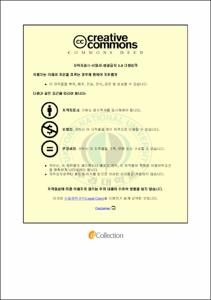어머니와 교사에 대한 복합애착 유형에 따른 만 5세 유아의 또래유능성
- Alternative Title
- Relationship between Attachment to Mother and Teacher and 5-year-old Children's Peer Competence
- Abstract
- ABSTRACT
Relationship between Attachment
to Mother and Teacher and 5-year-old Children's
Peer Competence
Hwang Sung Rang
Early childhood Education Major
Graduate School of Education
Pukyong National University
As dual career family and single-parent family have recently increased as a social problem, children who are taken care of children education institutes have risen as well. For this reason, the importance of peer relationship has been emphasized during early childhood. Positive peer relationship formed during early childhood also has important effects on human development after early childhood. Thus, relationships with mothers and teachers should be investigated to figure out how they impact on children's peer competence.
This study aims to analyze children's types of multiple attachment for mothers and teachers and how they impact on peer competence according to genders, offer significant data to educate and foster children, understand the characteristics and roles of attachment and discover the importance of teachers' roles including mothers' complicated influences.
Research problems according to the aims of the study are as in the following.
First, are there differences for peer competence according to children's types of attachment and genders towards mothers and teachers?
Second, are there differences for peer competence according to children's types of multiple attachment and genders towards mothers and teachers?
128 children and seven teachers teaching the children from three kindergartens in Busan were subject to the study to answer above two questions.
To evaluate child-mother attachment, Attachment Story Completion Task(ASCT) designed by Bretherton, Ridgeway, Cassidy(1990) and adapted by Lee Jin Sook(2001) was used for children directly. For child-teacher attachment, Attachment Q-set revised edition designed by Waters and Deanc(1985) and adapted by Lee Sang Eun(1999) was used and rated by teachers. To figure out children's peer competence, peer competence measure designed by Park Ju Hee and Lee Eun Hae(2001) was used for peer competence investigation observed and rated by teachers.
Collected data was analyzed through SPSS 21.0 to figure out gender distribution of teacher attachment and mother attachment, the average of peer competence according to genders, standard deviation, independent t verification to investigate the differences according to genders and two-way ANOVA to reveal differences of peer competence according to genders about mother attachment and teacher attachment, and according to multiple attachment types and genders.
The results of the study are as in the following.
First, when it comes to genders and peer competence according to types between children and mothers, group with unstable mother attachment had a significant difference more than another group with stable mother attachment. Boys had a significant difference more than girls for peer competence and the stable group had a significant difference more than the unstable group for sociality and prosociality as a sub factor. For teacher attachment type, there was a significant difference according to genders, girls had higher peer competence then boys, boys had less prosociality than girls as a sub factor.
Second, among multiple attachment type for children towards mothers and teachers, stable-stable group, stable-unstable group and unstable-stable group had a more significant difference of peer competence score than the unstable-unstable group. When peer competence according to children's gender was considered, girls had a more significant difference for peer competence score than boys.
As a result, children's peer competence towards mothers and teachers according to multiple attachment was statistically significant and when it comes to difference of peer competence according to children's genders, girls showed a more significant different than boys. Through the results, multiple attachment types formed by children towards mothers and teachers have effects on children's peer competence. Although a child had an unstable attachment with mother, if the child had a stable attachment with teacher, it is better for the child to have a unstable attachment with both of them. As the child can be still rewarded when the child suffers maladjustment to peer, roles of not only parents but also teachers have great effects on children's development. Enthusiastic relation formation and organized education should be carried out by children education institutes.
- Issued Date
- 2014
- Awarded Date
- 2014. 2
- Type
- Dissertation
- Publisher
- 부경대학교
- Alternative Author(s)
- Hwang, Sung Rang
- Affiliation
- 교육대학원
- Department
- 교육대학원 유아교육전공
- Advisor
- 이희영
- Table Of Contents
- 목 차
----------------------------------------------- Ⅵ
Ⅰ. 서론 ------------------------------------------------------ 1
1. 연구의 필요성 및 목적 ---------------------------------- 1
2. 연구문제 ----------------------------------------------- 7
3. 용어의 정의 -------------------------------------------- 8
Ⅱ. 이론적 배경 ---------------------------------------------- 10
1. 애착 ---------------------------------------------------- 10
가. 애착의 개념 ---------------------------------------- 10
나. 복합애착 ------------------------------------------- 12
다. 애착 측정 방법 ------------------------------------- 14
2. 또래유능성 --------------------------------------------- 18
가. 또래유능성의 개념 ---------------------------------- 18
나. 또래유능성의 관련변인 ----------------------------- 19
3. 애착과 또래유능성 -------------------------------------- 20
가. 애착과 또래유능성의 관계 -------------------------- 20
나. 복합애착 관련 선행연구 ---------------------------- 23
Ⅲ. 연구방법 -------------------------------------------------- 25
1. 연구대상 ------------------------------------------------ 25
2. 측정도구 ----------------------------------------------- 27
가. 애착이야기완성검사 -------------------------------- 27
나. Q-set 검사 ---------------------------------------- 33
다. 또래유능성 ----------------------------------------- 35
3. 연구절차 ------------------------------------------------ 37
가. 예비연구 -------------------------------------------- 37
나. 본연구 ---------------------------------------------- 37
4. 자료분석 ------------------------------------------------ 38
Ⅳ. 연구결과 -------------------------------------------------- 39
1. 변인의 기술통계 및 성별에 따른 또래유능성의 차이 ------ 39
2. 어머니와 교사에 대한 유아의 애착유형과 성별에 따른
또래유능성의 차이 --------------------------------------- 41
3. 어머니와 교사에 개한 유아의 복합애착유형과 성별에 따른
또래유능성의 차이 --------------------------------------- 45
Ⅴ. 논의 및 결론 ----------------------------------------------- 49
1. 논의 ----------------------------------------------------- 49
2. 결론 및 제언 --------------------------------------------- 55
---------------------------------------------------- 57
-------------------------------------------------------- 70
- Degree
- Master
- Files in This Item:
-
-
Download
 어머니와 교사에 대한 복합애착 유형에 따른 만 5세 유아의 또래유능성.pdf
기타 데이터 / 910.67 kB / Adobe PDF
어머니와 교사에 대한 복합애착 유형에 따른 만 5세 유아의 또래유능성.pdf
기타 데이터 / 910.67 kB / Adobe PDF
-
Items in Repository are protected by copyright, with all rights reserved, unless otherwise indicated.